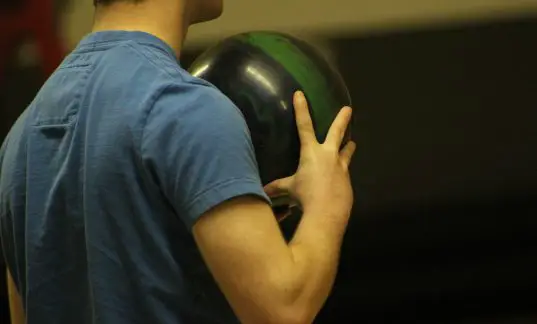If you’re new to bowling, you’re probably confused by all the oil gleaming on the lanes of your local alley. Why are bowling lanes so oily? What does oil contribute to the game? Does it help bowlers?
Whether you’re only going to bowl recreationally or you want to work your way up to playing in tournaments, you’re going to need a crash course in bowling oil patterns. After all, oil is often the lifeblood for a successful bowler — whether there’s money involved or not.
Rather than leaving you in the dark about things such as oil volume and the different types of bowling oil patterns, we’ve created this handy primer on the slick stuff.
Let’s get started with a simple question we hear all the time.
Why do they put lane oil on bowling lanes?
Without oil in the middle of the lane and around it, bowling balls could easily damage a wood or synthetic bowling lane surface. For recreational bowling centers and those contracted by the Professional Bowlers’ Association (and semi-pro bowling leagues running bowling tournaments around the world), oil volume plays a pivotal role in keeping playing surfaces playable for millions of bowlers like yourself.
In addition to the things that oil provides for lane protection, it’s also a pivotal asset for bowler and bowling ball alike. Without proper oil distance and slicker lane conditions, there wouldn’t be enough friction for consistent ball hooks, skid, or length down the middle of the lane.
What are the different oil patterns in bowling?
There are two main types of bowling oil patterns — a sport pattern and a house pattern.
What are sport bowling oil patterns?
Sport patterns are complex, intricate oil configurations that often require expert navigation to overcome and post high scores. Sport patterns are common in semi-professional and professional bowling circuits. Some sport patterns coax right-hander misses. Some are more advantageous for right-handers with sharp hooks. And others can make the pocket jump around on an inexperienced bowler, splicing pattern variables from different categories to create the bowling version of a puzzle.
The Professional Bowlers’ Association utilizes 16 different sport patterns — each of which can prompt bowlers to shoot the laneman an angry glance or two. No two PBA patterns are the same, although they are separated into two different series — Animal and Legend. Here are the 16 different sport oil patterns used by the PBA Tour in tournament play —
PBA Legend Patterns
- PBA Johnny Petraglia 36
- PBA Don Carter 39
- PBA Don Johnson 40
- PBA Earl Anthony 42
- PBA Mark Roth 42
- PBA CP3 42
- PBA Carmen Salvino 44
- PBA Dick Weber 45
PBA Animal Patterns
- PBA Wolf 33
- PBA Cheetah 33
- PBA Viper 36
- PBA Bear 39
- PBA Chameleon 39
- PBA Scorpion 42
- PBA Shark 45
- PBA Dragon 45
What are Kegel patterns?
Most other professional bowling leagues and semi-professional bowling leagues use the Kegel series of sport patterns and challenge patterns for their events. For those leagues and events sanctioned by the USBC and otherwise, Kegel patterns provide a little bit of everything for everyone. Their Sport patterns are complex and challenging for professional bowlers. Their Challenge patterns are a good mid-level conquest for intermediate and league bowlers. And, their Recreational patterns are often easy enough for those who’ve never seen a lane machine before.
Kegel oil machines have an oil head that goes back and forth on the lane, depositing a precise amount of slick stuff in the right spots to complete the pattern as designed.
Kegel has two types of patterns separated by skill level — Navigation patterns and Landmark patterns. Some of these patterns force bowlers to attack a certain part of the lane with gusto. Others require very little information to use your ball to string together lots of marks.
If you’ve got your laser printer handy, here’s a definitive list of Kegel patterns separated by type and skill level.
Kegel Navigation patterns
- Recreational — Main Street, High Street, Stone Street, Wall Street, Bourbon Street, Easy Street, various house patterns
- Challenge — Route 66, Middle Road, Sunset Strip, Beaten Path, Broadway, Abbey Road
- Sport — Turnpike, Winding Road, Dead Man’s Curve, Boardwalk, Autobahn, Highway to Hell
Kegel Landmark patterns
- Recreational — Great Wall of China, Gateway Arch, Big Ben, Stonehenge, various house patterns
- Challenge — Statue of Liberty, Chichen, Itza, Taj Mahal, Tower of Pisa
- Sport — Alcatraz, Sphinx, Red Square, Eiffel Tower
What are house patterns?
For those outside the bowling world looking to get started, house patterns are the way to go. Often used at recreational bowling alleys around the world, house oil patterns are designed to help beginner bowlers find the pins and get on the board.
House patterns vary from alley to alley, but the general idea is very much the same — more oil down the middle of the lane, less oil to the side. This helps inexperienced players track the ball to the pin pocket much easier. It also helps bowlers find a target that works for them and stay with it.
More oil in the middle means more action going towards the sweet spot of the pins. It also helps wilder bowlers with a greater margin for error when it comes to off-throws.
What oil pattern do most bowling alleys use?
If you’re headed to your local bowling alley on a random Friday night, chances are that you’ll be playing on a house pattern. When you read an article or articles which provide tips for beginning bowlers, the advice is usually given with a standard house pattern in mind.
With added oil volume in the middle of the lane and less to the sides, recreational bowling alleys can serve a wider variety of bowlers with all different types of skill sets. When these alleys host tournaments, they may alter the oil patterns to capture the attention (and ire) of more experienced players.
However, the vast majority of alleys use house patterns on their lanes to keep the game friendly for kids, killer bowlers, and everyone in between.
How do oil patterns affect bowling?
Every time you play a game of bowling, oil pattern length, oil pattern distance, and other oil variables alter user experience in significant ways. If a pattern is predictable and simple, you can get into a groove much easier. If a pattern is unpredictable and complex, it may take a couple of games for you to figure out your target and your alignment.
With a traditional house pattern, the oil configuration is laid out to help you keep the ball near the middle of the lane. When your mechanics are off or when you’re just learning the game, this can be a valuable aid.
Sport patterns are much different. They are laid out to provide massive challenges to bowlers who’ve been around the block a time or two. Some are slicker on one side to aid certain hook shots and punish others. Others get dry in some spots to wreak havoc down the lane. It’s tricky stuff.
Also, certain balls react better to more oil than others. The latest generation of bowling equipment, such as reactive resin bowling balls, are built to absorb oil as a means of generating power and oomph. These balls are made for slicker lanes. Older, polyurethane balls tend to get lost in deep oil. They are more suited to medium-dry lanes.
In short, oil patterns affect your throws in a variety of ways. No matter what oil pattern you’re playing on, you’ll need patience and a discerning eye to turn oil into bowling score gold.
What should you know about playing on a typical house pattern?
When playing on a typical house pattern, straight shots and shorter hooks are rewarded. A house oil pattern also has plenty of predictability for advanced players to exploit. A bowler that can figure out their breakpoint with the “Rule of 31” can do serious damage with longer, wider hooks. What is the “Rule of 31?”
Check out how many feet of the lane that the oil pattern covers. Subtract that number by 31. The result is the board where your ball should be located when it starts to hook. For example, if a pattern is 41 feet long, your ball should begin its break on board 10. Expert bowlers can use this information to tweak their throws and slot their hooks in for big strikes and big booms.
In truth, house patterns are laid out to minimize variables. As long as you can get your form and footwork down, you can make good things happen on the lane and at the pins.

